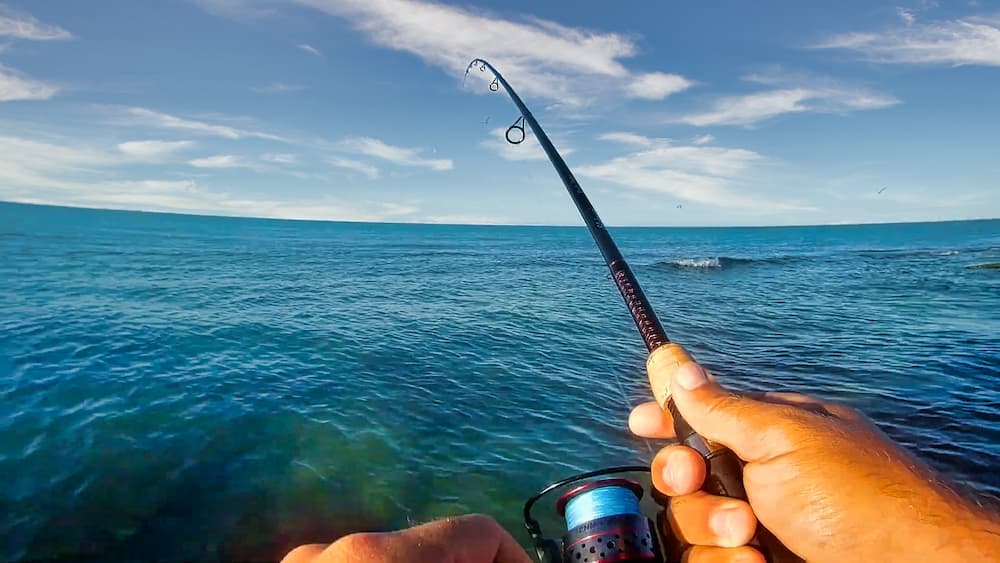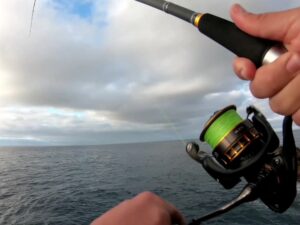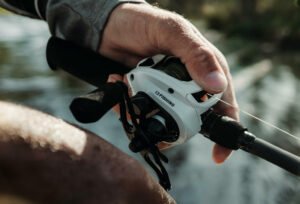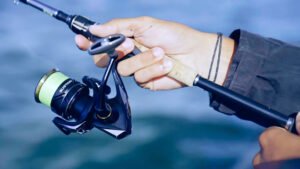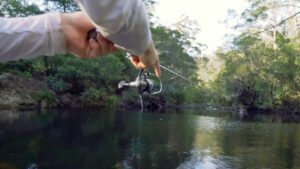Over the last 20 years, more and more anglers are turning to spinning reels for their primary fishing reel because of their ease of use and durability. Spinning reels have been around for a long time. In fact, the first spinning reel was invented in England in 1905. It wasn’t until the early 20th century when this reel began to catch on in the United States.
Today, manufacturers offer a variety of baitcasting, spincast, and spinning reels. Each reel is specifically designed to handle a certain type of fishing. In this article, you’ll learn what makes a spinning reel a spinning reel, their various parts, and how to use them.
How Spinning Reels Work
A spinning reel is a type of fixed-spool reel. This means that the line is stored on a stationary spool. The line is released in coils or loops from the leading edge of the spool.
To shorten or stop the outward cast of a lure or bait, the angler uses a finger or thumb placed in contact with the line and/or the leading edge of the spool. The rotating bail or line pickup winds the line onto the spool as the lure is retrieved.
Parts Of A Spinning Reel
There are four primary components that make up a spinning reel: the body, bearings, gears, and spool.
The body is the largest part of the reel and is made of either plastic or metal. The body houses the bearings, gears, and spool.
The bearings are located in the body and allow the gears to rotate. The bearings are either sealed or open. Sealed bearings are less likely to get dirty and require less maintenance than open bearings.
The gears are located in the body and are responsible for transferring the power from the handle to the spool.
The spool is located in the body and is responsible for holding the line. The spool is either made of plastic or metal.
The handle is located in the body and is attached to the gears. The handle is used to crank the reel.
The line spool is located on the spool and is responsible for holding the line. The line spool is either made of plastic or metal.
The line roller is located on the spool and is responsible for guiding the line onto the spool.
The reel foot is located on the body and is responsible for attaching the reel to the rod.
The drag is located on the body and is responsible for adjusting the amount of force that is applied to the line.
How to Use a Spinning Reel
The most important things to remember when using a spinning reel are to maintain a light drag, take your time while cranking the reel, and let the reel do the work.
“Spinning reels are easy to use and need to be treated gently. They should be reeled in slowly and steadily, with pressure only at the beginning and end of the retrieve.”
To use a spinning reel properly, first put the reel on the rod. Next, you should take the line from the side of the reel and tie it to the hook. Then, cast the line into the water. When you feel a bite, don’t put too much pressure on the fish. Instead, reel the fish in slowly. When the fish is close to the boat, you can reel faster.
Repeat until the fish is removed from the water.
How to Cast a Spinning Reel
To cast a spinning reel, you will first want to gentle hold the fishing line with your index finger while opening the bail wire with your free hand.
Next, bring your fishing rod back behind you, and then swing it forward while simultaneously releasing the fishing line from your index finger. This will cause the line to uncoil and the lure to fly through the air and into the water.
How to Spool a Spinning Reel
To spool a spinning reel, you will first want to make sure that the reel is properly attached to the rod. Next, take the line from the side of the reel and tie it to the hook. Then, make sure that the line is coming off of the reel in the correct direction.
You will want to hold the spool with your left hand and crank the handle with your right hand. If the line is coming off the spool in the wrong direction, you can correct it by reversing the spool and handle. Finally, put tension on the line by gently pulling on it while you are cranking the handle.
How to Maintain a Spinning Reel
The most important part of reel maintenance is to make sure that the reel is always clean. This is especially important if you like to fish in sandy or muddy areas. You can clean your reel with soap and water.
Be extremely careful not to damage any of the reel’s parts when doing so. You should use a soft clean cloth or towel. If you find that the reel is especially dirty or wet, you can rinse the reel in fresh water. Never use hot water or strong cleaning solutions, as this could damage the reel.
After you clean your spinning reel, you should wipe it with a soft dry cloth to remove any remaining moisture.
If you find that your reel is extremely dry and squeaky, you should oil it. This is also a good opportunity to check the bearings and gears. If you find that they are beginning to get worn, you should replace them.
If they are not worn, you can use grease to lubricate them and keep them spinning. To maximize the life of your reel and protect it from wear, it is essential to keep it lubricated and properly maintained.
How to Store a Spinning Reel
Finally, you should always store your reel in a cool, dark place. Be sure to use a reel cover to protect it from damage. Also, be sure to take off the line and put it in a separate container. This will make it easier to spool your reel when you are ready to use it.
Conclusion
Spinning reels are extremely easy to use, but it is important to properly maintain them. You should always clean your reel and oil it to help protect it from wear or damage.
It is also important to never submerge your reel in water unless it is specifically designed for it. Spinning reels are one of the best choices for anyone that is just starting to fish. They are incredibly easy to use and can be used for almost any type of fishing.
If you find that you are having trouble using or maintaining your spinning reel, be sure to contact the manufacturer or a local fishing expert.

